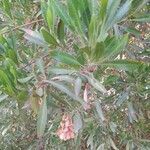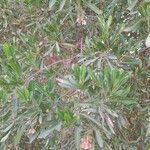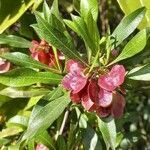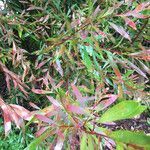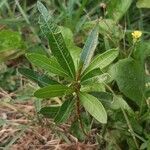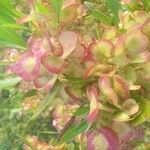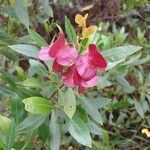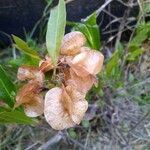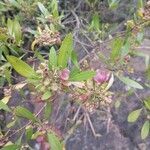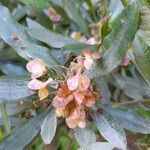Shrub or treelet, up to 8 m high, dbh up to 20 cm; bark smooth with fine ridges, outer reddish brown, inner pale yellow; sap wood yellowish. Indumentum glabrous or nearly so. Leaves elliptic to obovate, (including the petiole) (5-)9-15 by (1.5-)2.5-4 cm, index 3-4.5, thin-pergamentaceous to papyraceous; apex narrowly rounded and minutely acuminate (to broadly rounded); midrib above moderately raised and rounded; nerves 4-8 mm apart, widely spreading, ending free; intersecondary nerves often present, well-developed; reticulations fine, above grooved, slightly raised beneath. Inflorescences 3-3.5 cm long, laxly and widely branched, with 12-15 flowers; pedicels in fruit 1.2-1.5 cm long. Flowers bisexual. Sepals (3 or) 4, elliptic, c. 2.75 by 1.5-1.75 mm, outside sometimes with a few paired hairs, the margin sparsely ciliate mainly towards the apex, glabrous inside; the scar under the fruit strongly lobed. Stamens 5-7, scars distinct in fruit; filament c. 0.2 mm long; anther basally attached, c. 1.8 mm long, ciliate at apex. Pistil 2-(or 3-)locular; ovary flattened-ellipsoid, c. 1.25 by 1 mm, glabrous; style columnar, 2-3 mm long, with some glands, caducous; stigma slightly lobed. Fruits inflated, reniform-cordate, 8-12 by 11-16 mm, membranous, yellowish to light brown, very sparsely glandular, otherwise glabrous; wing at the middle of the fruit (l-)2.5-4 mm wide, membranous.
Shrubs or small trees, 1-3 m tall or higher. Branches flat, narrowly winged or ridged, with sticky juice. Leaves simple; petiole short or nearly absent; blades variable in shape and size, linear, linear-spoon-shaped, linear-lanceolate, or oblong, 5-12 × 0.5-4 cm, papery, both surfaces with sticky juice, glabrous, nitid when dry, lateral veins many, dense, very slender, margin entire or inconspicuously shallowly wavy, apex acute, obtuse, or rounded. Inflorescences terminal or axillary near apices, shorter than leaves, densely flowered, rachis and branches ridged. Pedicels 2-5 mm, sometimes to 1 cm, slender. Sepals 4, lanceolate or narrowly elliptic, ca. 3 mm, apex obtuse. Stamens 7 or 8; filaments less than 1 mm; anthers incurved, ca. 2.5 mm, glandular. Ovary ellipsoid, abaxially with sticky juice, 2-or 3-loculed; style ca. 6 mm, apex 2-or 3-lobed. Capsules obcordiform or compressed-globose, 2-or 3-winged, 1.5-2.2 cm tall, with wing 1.8-2.5 cm wide; testa membranous or papery, veined. Seeds 1 or 2 per locule, black, lenslike. Fl. late autumn, fr. late autumn-early spring. 2n = 28.
Shrub 1-3 (-6) m tall, glabrous; branches slightly angled, viscidous. Leaves simple; petioles 2-3 mm long; blade oblanceolate or elliptic, 5-10 × 1.8-3.6 cm, chartaceous, glabrous, varnished when young, the apex rounded or less often obtuse, apiculate, the base cuneate to acuminate, sometimes slightly asymmetrical, the margins entire, revolute, midvein slightly prominent. Panicles ca. 3 cm long, the axes varnished; bracteoles minute. Flowers bisexual, sticky; sepals 4-5, oblong-elliptic, greenish yellow, 2-2.5 mm long, ciliate on margins, revolute at anthesis; stamens (6)8(10), nearly sessile; gynoecium 2-3-carpellate. Capsules papery, retuse at apex and base, straw-colored, 2-3-locular, the cocci semi-circular, inflated in the center, dorsally winged, 1.5-2 cm long; pedicel 1-1.2 cm long. Seeds 2 per locule, nearly rounded, ca. 3 mm long, dull black.
Dioec. glab. shrub or tree up to 6 m. tall or occ. much more, but us. flowering when ± 2 m. tall; sts prostrate in coastal strongly insolated places. Bark reddish brown, falling in flakes; young branchlets compressed to triangular, viscid. Lvs alt. to subopp., occ. three close-set, on petioles up to 10 mm. long. Lamina thinly coriac., ± 4-10 × 1-3 cm., pale green, entire, narrow-obovate to narrow-elliptic, obtuse (rarely subacute, sts minutely retuse) gradually narrowed to base. Infl. a terminal rather densely fld panicle, ± 3-4 cm. long. Fls greenish to yellowish or reddish, on pubescent pedicels ± 4 mm. long. ♂ with 4 c. oblong sepals; 8-10 stamens, filaments very short. ♀ with 4 narrower sepals; style 2-fid, far exserted. Capsule ± 15 × 15 mm. including broad wings, compressed. Sts 3 wings are present.
Dioecious or polygamo-dioecious spreading or erect shrub or tree to 8 m high. Leaves simple, sessile or petiolate, linear to obovate or spathulate, rarely cuneate to angular-obovate, obtuse to acuminate, sometimes rounded and mucronate, rarely emarginate or 3-toothed, entire to irregularly sinuolate or denticulate, attenuate to cuneate at base; lamina 1–15 cm long, 0.1–4 cm wide, glabrous; petiole 2.5–18 mm long. Flowers in terminal panicles; pedicels 3–9 mm long. Sepals 3 or 4, lanceolate to ovate, 1.3–3 mm long, caducous. Stamens 6–10, usually 8. Ovary pubescent or glabrous. Capsule 2–4-winged, broadly elliptic to transversely elliptic in lateral view, 8.5–28 mm long, 11–28 mm wide, glabrous; wings 3–10 mm wide, membranous or sometimes coriaceous; dehiscence septifragal. [See also Green 1994: 243.]
Dioecious shrubs or trees 2-5 m tall; wood brown, close grained, hard; stems reddish, angled, glabrous, minutely fissured and lenticellate. Leaves oblong-lanceolate to linear-lanceolate, simple, sessile or short-petiolate, acute to rounded at the apex, attenuate at the base, 5-12 cm long, 1.5-5 cm wide, viscid and gla-brous, the margin entire. Thyrses axillary or terminal, shorter than the leaves, racemiform or corymbiform. Flowers pale yellowish; sepals usually 4, ca. 3 mm long; petals absent. Capsules suborbicular, winged, obcordate, cordate at the base, 2.2 cm long, 2.5_cm wide, 3-winged, 3-locular; seeds lenticular, black.
A shrub or small tree. It can be 10 m high. It can have many stems. The leaves are sticky and are 3-10 cm long. They are narrow with wavy edges. A variety with purple leaves also occurs. The flowers are greenish. Male and female flowers occur on separate plants. The fruit are hops 18 mm long and with wings. They occur in clusters at the ends of branches. They can be red or white. Many different kinds or subspecies of this plant occur. The seed is edible.
Leaves simple, spirally arranged; petiole up to 6 mm. long, glabrous; lamina up to 10 × 3 cm., narrowly elliptic, glabrous, resinous, apex acute and usually acuminate, margin entire, base narrowly cuneate and decurrent into the petiole; lateral nerves numerous (usually up to c. 20 pairs).
Dioecious or bisexual, small tree, up to 3-5(-10) m tall. Leaves linear-oblanceolate, resinous, pale green. Flowers in small, rounded axillary and terminal panicles, greenish yellow. Fruit winged.
Fruit up to 2 × 2 cm., 2–3(4)-locular, subcircular in outline, emarginate at apex and base, with 2–3 glabrous membranous wings c. 4–6 mm. broad, very shortly stipitate.
Dioecious, small tree to 5(-10) m. Leaves linear-oblanceolate, resinous. Flowers in small, rounded, axillary and terminal panicles, greenish yellow. Fruits winged.
Flowers greenish-yellow (often bisexual fide Radlkofer); pedicels up to 5 mm. long (accrescent to 12 mm. long in fruit), filiform, glabrous.
Inflorescence usually c. 2 cm. long, terminal or subterminal, somewhat corymbose; peduncle short (rarely more than 5 mm. long).
Small tree up to 10 m. tall or shrub; branchlets angular, glabrous, resinous.
Ovary (2)3(4)-locular; style 4–6 mm. long, (2)3(4)-lobed.
Seed black, 3 × 2 mm., lenticular, glabrous.
Stamens usually 6; anthers 3 mm. long.

